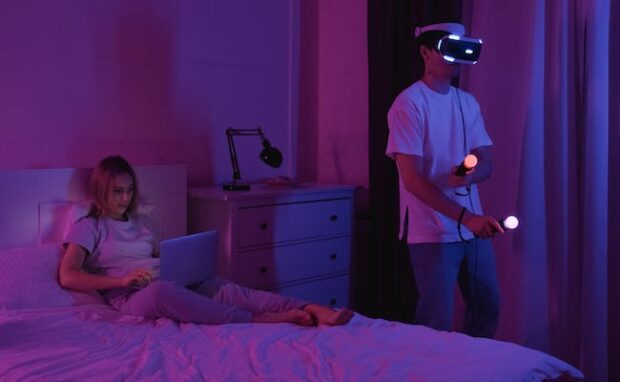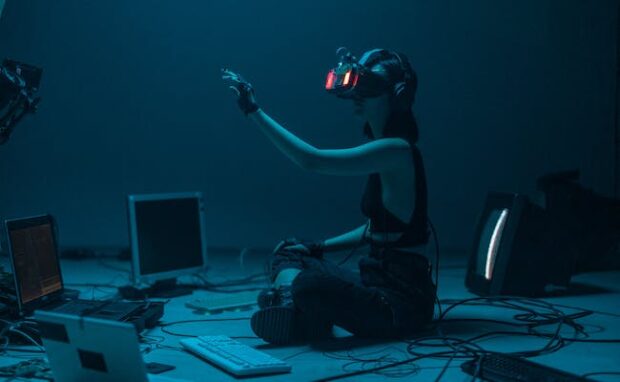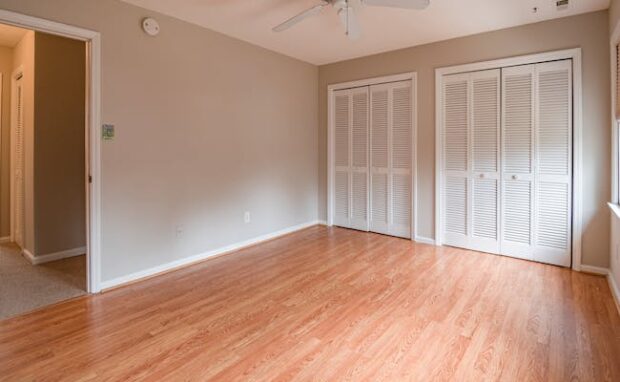5 things to consider before getting a VR headset
Apple recently released its Apple Vision Pro, a VR headset designed for daily use instead of gaming only.
We may scoff at the $ 3,500 device today, but it might be its next iPhone. Previously, the touchscreen cellular phone did not catch on with users outside the US. Eventually, the iPhone and similar devices became part of everyone’s pockets.
Everyone should prepare if the Vision Pro becomes the next big thing. After all, handling such a gadget isn’t as simple as a laptop or a phone. You must consider several factors before you add virtual reality to your daily routine. Let’s explore them so tech enthusiasts and regular folks can catch up with this emerging technology.
5 things to consider for your first VR headset:
- Price
- Standalone or tethered
- PC specs
- Tracking method
- Room space
1. Price

The first you’ll notice in every VR headset is the price. Previously, only large brands like Sony dominated the market. We now have more choices, and this handy guide from Lifewire comes in handy:
Less than $300
- Standalone
- Tethered option available in specific models
- 1832×1920 resolution per eye
- Can’t play the latest games without linking to a PC
- Has inside-out tracking
$300 to $600
- Tethered
- Not wireless
- May not include controllers or tracking
- Outside-in tracking
- 1,440×1600 resolution per eye
$600 to $1,000
- Tethered
- Not wireless
- May not include a tracking system or controllers
- Outside-in tracking
- 2,880×1,600 resolution per eye
$1,000 to $1,200
- Tethered
- Not wireless
- Will include controllers and a tracking system
- Outside-in tracking
- 2,448×2,448 resolution per eye
$1,300 to $1,600
- Tethered
- Wireless
- Has a tracking system and controllers
- Outside-in tracking
- 2,448×2,448 resolution per eye
2. Standalone or tethered

The latest VR headsets are standalone models, meaning you don’t need to attach them to a computer to function. They can accept, process, and project audio and visual information without a PC handling data.
For example, the Apple Vision Pro only needs to set up a few minutes with your iPhone or other Apple devices to complete the setup. Then, it’s ready to go.
However, models outside Apple’s latest flagship product usually have lackluster graphics and framerates. After all, they only rely on their built-in processors which are typically weaker than most PCs.
You may also like: How Much RAM Do You Need?
In other words, standalone VR headsets often sacrifice performance and visuals for comfort. On the other hand, tethered headsets rely on a PC’s processing power to do the heavy lifting.
That means you’ll have to link your headset to a computer. Of course, the performance will depend on how powerful your rig is.
3. PC specs

If you want the utmost performance or an affordable system, you will likely pick up a tethered model. Refer to the guide below to ensure you have a computer powerful enough to handle your headset:
Meta Quest
- CPU: Intel i5-4590 / AMD Ryzen 5 1500X or greater
- RAM: 8GB
- Ports: 1x USB port
- OS: Windows 11/10.
Valve Index
- CPU: Quad Core +
- GPU: NVIDIA GeForce GTX 1070 or better
- RAM: 8GB
- Ports: 1x USB 3.0 + 1x DisplayPort
Oculus Rift S
- CPU: Intel i5-4590, AMD Ryzen 5 1500X or greater, NVIDIA GTX 1060 / GTX 970 / AMD Radeon RX 480 / R9 290 or greater
- RAM: 8GB
- Ports: 1x USB 3.0 + 1x DisplayPort (or Mini DisplayPort)
Windows MR/Samsung Odyssey+
- CPU: Intel Core i5 4590 / AMD Ryzen 5 1400
- GPU: NVIDIA GTX 1060 / AMD RX 470/570 or greater
- RAM: 8GB
- Ports: 1x HDMI 2.0 or DisplayPort + 1x USB 3.0 port.
HP Reverb G2
- CPU: Intel Core i5, i7, Intel Xeon E3-1240 v5 or higher, AMD Ryzen 5 or higher
- RAM: 8GB
- Ports: 1x DisplayPort 1.3, 1x USB-C
- OS: Windows 10 May 2019 update or later.
You may also like: OpenAI is developing ChatGPT robots
HTC VIVE XR Series
- CPU: Intel CoreTM i5‑4590 or AMD RyzenTM 5 1500X equivalent or better
- GPU: NVIDIA GeForce GTX 1060 6 GB equivalent or better, AMD RadeonTM RX 580 equivalent or better
- RAM: 8GB
- Ports: 1x USB 3.0
- OS: Windows 11/10.
Lifewire says these are the recommended specifications, which are more reliable than the minimum ones. However, the best way to see if your PC is VR-ready is to use free system information tools.
4. Tracking method

VR headsets let you move in virtual space, so they must have ways to monitor your movements. Lifewire says there are two ways VR headsets track users: outside-in and inside-out.
Outside-in systems have base stations on your desk or around your room. They follow your movements, or the VR headgear monitors the base stations.
You may also like: Japan port resumes after cyberattack
These trackers let you move around virtual reality by moving in the real world called room-scale VR. On the other hand, inside-out systems use the headset’s systems to track the relative positions, speed, and direction of surrounding objects.
Most inside-out systems don’t require additional setup, making them easy to use. However, they aren’t always as accurate as outside-in systems.
5. Room space

Traversing virtual reality requires a spacious room because you’ll be moving with your whole body. Ensure you don’t have any furniture and other knick-knacks that may hit or trip over.
Avoid overhead lamps, electric fans, or other stuff dangling from your ceiling. Otherwise, you might injure yourself while playing.
You may also like: How to check your PC temperature
Online technology guide TechTarget says your room should be at least 6.5ft x 5ft or 2m x 1.5m. Most VR headset setups require showing your room to its camera.
It will involve setting up camera trackers around your room that will estimate your moving space. Then, it will tell you whether you lack space so that you can adjust your room in real-time.
Frequently asked questions about VR headsets
What are the available VR headset models?
Some of the long-standing VR headset models include the HTC Vive and the Oculus Rift. However, there are more options available for specific purposes. For example, the Valve Index was specifically designed for gaming. At the time of writing, the latest, cutting-edge model is the Apple Vision Pro.
Should I get a VR headset?
The best VR headset will depend on your purpose. For example, if you are an avid gamer, you might want to grab one to play trendy titles like Lethal Company. Also, VR headgear could become essential for aspiring vtubers, which are online content creators that appear as digital avatars.
What are the VR headset health risks?
Gadget store Vesttech says that VR headsets can cause severe eyestrain. They give you a wide field of view by placing a screen in front of your eyes, which could quickly stress and dry them. Also, the constant movement and visual information may overwhelm your brain and make you nauseous.